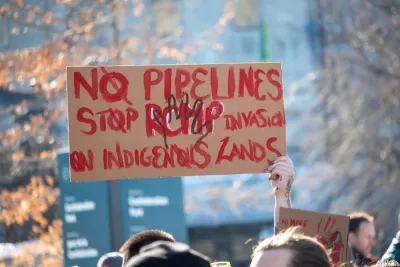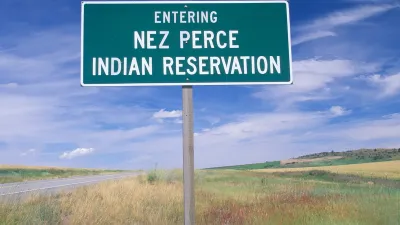A 500-year struggle has gained momentum in the days of social media.

An article by B. Toastie for High Country News explains the Land Back movement, which has been gaining prominence as the internet spreads the words. The Land Back movement, as the name clearly implies, goes beyond land acknowledgement, which has also gained mainstream traction in recent years.
There’s a simple explanation for the demands of the movement. To explain, the article poses the question: “What is the LandBack movement really asking for?” The answer is simple: “The land. Back.”
The movement won a major Land Back victory of the return of Blue Lake back to the Taos Pueblo in 1970, but a social media hashtag has raised awareness of the movement more into the mainstream. “In mid-2019, the hashtag gained traction in North America during the Tiny House Warriors’ blockade of the Trans Mountain Pipeline in unceded Secwepemc territory,” writes Toastie. “Soon after, the Yellowhead Institute, an Indigenous-led policy research center at Toronto Metropolitan University, released a report called Land Back that examined settler-colonialism at work in present-day Canada. In August 2020, the advocacy group NDN Collective launched landback.org with a brief LandBack Manifesto, followed by a campaign launch on Indigenous Peoples Day.”
According to the article, the appointment of Deb Haaland (Laguna Pueblo) as secretary of the Interior, and of Chuck Sams (Umatilla) as director of the National Park Service, the first Native people to hold either office is also furthering the cause.
The source article includes a lot more discussion and explanation.
FULL STORY: Questions about the LandBack movement, answered

Maui's Vacation Rental Debate Turns Ugly
Verbal attacks, misinformation campaigns and fistfights plague a high-stakes debate to convert thousands of vacation rentals into long-term housing.

Planetizen Federal Action Tracker
A weekly monitor of how Trump’s orders and actions are impacting planners and planning in America.

Chicago’s Ghost Rails
Just beneath the surface of the modern city lie the remnants of its expansive early 20th-century streetcar system.

Bend, Oregon Zoning Reforms Prioritize Small-Scale Housing
The city altered its zoning code to allow multi-family housing and eliminated parking mandates citywide.

Amtrak Cutting Jobs, Funding to High-Speed Rail
The agency plans to cut 10 percent of its workforce and has confirmed it will not fund new high-speed rail projects.

LA Denies Basic Services to Unhoused Residents
The city has repeatedly failed to respond to requests for trash pickup at encampment sites, and eliminated a program that provided mobile showers and toilets.
Urban Design for Planners 1: Software Tools
This six-course series explores essential urban design concepts using open source software and equips planners with the tools they need to participate fully in the urban design process.
Planning for Universal Design
Learn the tools for implementing Universal Design in planning regulations.
planning NEXT
Appalachian Highlands Housing Partners
Mpact (founded as Rail~Volution)
City of Camden Redevelopment Agency
City of Astoria
City of Portland
City of Laramie





























